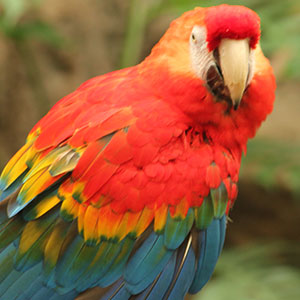
How Parrots Age
Is My Bird Old?
We know our pets are getting older, but how old are they? Unless we obtained our bird directly from the breeder that raised him, most of us do not know the exact age of our birds. At best, we can make an educated guess, taking into consideration the average life expectancy of the species, how long we've owned them and interpreting the "signs."Behavioral Changes
Birds, just like humans, begin showing signs of aging around midlife, when their hormones typically change. For large birds such as Amazons, African greys, cockatoos and macaws, midlife is normally around 35 years of age or after as they have a life expectancy of well over 50 years. Birds do not go through "menopause," but they may start to exhibit many of the same signs associated with this type of hormonal change.Crankiness can be a sign! If your bird normally was tolerant when interacting with new people or routines but now is acting out and showing displeasure, it may be a sign of aging. The opposite can also happen, instead of being crabby, your bird may become mellow. Maybe your bird was full of energy but now is less active and wants to sleep or stay in the cage more. Just like humans, the aging process varies from bird to bird and a sign of what we may think is aging, may actually be a sign of illness or disease! If there is any question, you should visit your avian veterinarian.
Physical Changes
According to Brian Speer, DVM, DABVP, of Oakley, California, the physical changes are very subtle in aging parrots. You may have a 35 year-old Double Yellow-Headed Amazon in the same cage as one who is three and may not see any physical differences. However, there are a few physical signs you might see.Older bird's feathers may start to look dull and you may see evidence of feather damage from preening too much, not enough or just not good at it anymore.
According to Greg Burkett, DVM, DABVP, an avian veterinarian in Durham, N.C. degenerative eye disorders are common in aging birds. He stated "Other ophthalmological changes include changes in iris color, loss of tone in the lids and uveitis." An Amazon's parrots' eyes may turn from orange to amber yellow and some birds may develop droopy eyelids. A more serious eye condition that older birds may develop is cataracts. Indications are when the pupil changes from black or gray to an opaque white, squinting or redness of the eye. Cataracts may develop very quickly in some birds and rapidly leads to blindness.
Weight gain or loss and muscle wasting may be another indication your bird is geriatric. Weight gain and muscle wasting may be related to a decreased level of exercise, according to Dr. Burkett. If they are losing weight, they may be having a more difficult time getting to their food.
Skin changes have also been observed and are mostly seen on the face and feet. Some parrots may get wrinkling, pigment spots and blemishes in the skin but is only seen on birds with bare facial patches such as macaws. Splotchy depigmentation on the feet is also common, according to Dr. Burkett. Sometimes the tops of the feet become scaly, flaky, dry and gnarly looking, while the bottoms of the feet become thinner and smoother. You may also notice small bald spots on the underside of the feet.
Age Related Illness
As birds get older they are more prone to certain types of medical conditions. As a general trend, according to Speer, "we see less infectious disease problems and more health issues related to nutrition, metabolic, cardiovascular and neoplastic (cancer). Older birds will still get infections, but these other types of medical conditions will become bigger problems with age." Speer said, this is very similar to humans, many cardiovascular problems or cancers seem to require age and time.Avian veterinarians seem to agree that lack of proper nutrition throughout the bird's life is the primary cause of most of these "old age" ailments. The most common ailments seen in avian patients are:
Heart Disease
Atherosclerosis is also common in geriatric psittacine birds, with the exception of African greys, in which the disease has been noted in the very young. "Atherosclerosis may at least presumptuously be attributed to years or high fat dietary intake combined with relatively low physical activity," said Speer.
Arthritis
Cataracts
Other ophthalmic conditions in geriatric birds may include corneal alterations, third eyelid abnormalities, anterior uveitis, infection of the conjunctiva (i.e. Chlamydophila and Mycoplasma) and lymphoma.
Cancer
Liver Diseas
Kidney Disease
Caring For Seniors
If your bird is showing signs of old age, it may be too late to correct their ailments, but you can help them live more comfortably. Arthritic birds will appreciate a variety of perches including thermo-perches that emit heat. Ask your veterinarian if giving pain medication is an option. Your veterinarian may be able to make dietary recommendations to combat certain diseases. Most importantly, your veterinarian can confirm if the "signs" you are seeing is simply due to age and not an infection or illness.Discover More!
Fatty Liver Disease in BirdsPet Bird Nutrition
Bird Feather Health and Anatomy
Obesity in Birds
Return to Bird Articles


